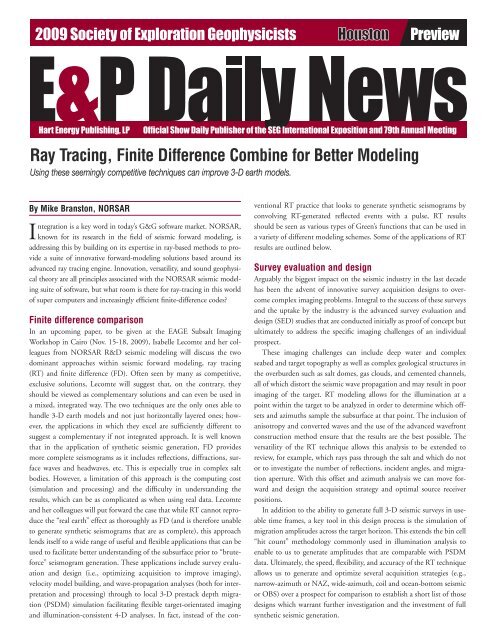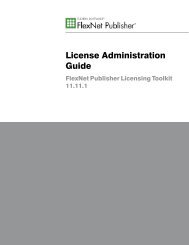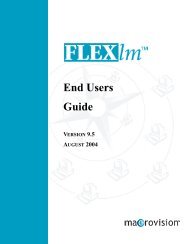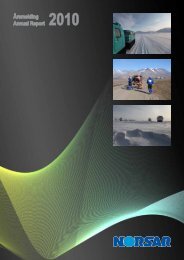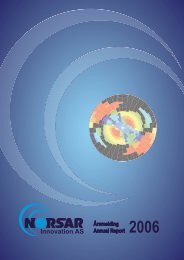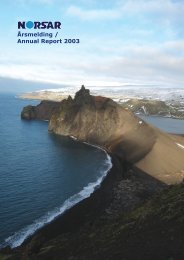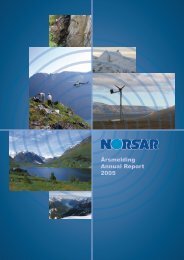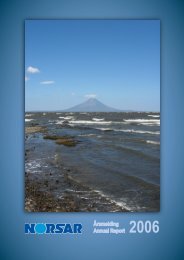SEG-RayTrace:Layout 1 - norsar
SEG-RayTrace:Layout 1 - norsar
SEG-RayTrace:Layout 1 - norsar
You also want an ePaper? Increase the reach of your titles
YUMPU automatically turns print PDFs into web optimized ePapers that Google loves.
2009 Society of Exploration Geophysicists Houston Preview<br />
Hart Energy Publishing, LP Official Show Daily Publisher of the <strong>SEG</strong> International Exposition and 79th Annual Meeting<br />
Ray Tracing, Finite Difference Combine for Better Modeling<br />
Using these seemingly competitive techniques can improve 3-D earth models.<br />
By Mike Branston, NORSAR<br />
Integration is a key word in today’s G&G software market. NORSAR,<br />
known for its research in the field of seismic forward modeling, is<br />
addressing this by building on its expertise in ray-based methods to provide<br />
a suite of innovative forward-modeling solutions based around its<br />
advanced ray tracing engine. Innovation, versatility, and sound geophysical<br />
theory are all principles associated with the NORSAR seismic modeling<br />
suite of software, but what room is there for ray-tracing in this world<br />
of super computers and increasingly efficient finite-difference codes?<br />
Finite difference comparison<br />
In an upcoming paper, to be given at the EAGE Subsalt Imaging<br />
Workshop in Cairo (Nov. 15-18, 2009), Isabelle Lecomte and her colleagues<br />
from NORSAR R&D seismic modeling will discuss the two<br />
dominant approaches within seismic forward modeling, ray tracing<br />
(RT) and finite difference (FD). Often seen by many as competitive,<br />
exclusive solutions, Lecomte will suggest that, on the contrary, they<br />
should be viewed as complementary solutions and can even be used in<br />
a mixed, integrated way. The two techniques are the only ones able to<br />
handle 3-D earth models and not just horizontally layered ones; however,<br />
the applications in which they excel are sufficiently different to<br />
suggest a complementary if not integrated approach. It is well known<br />
that in the application of synthetic seismic generation, FD provides<br />
more complete seismograms as it includes reflections, diffractions, surface<br />
waves and headwaves, etc. This is especially true in complex salt<br />
bodies. However, a limitation of this approach is the computing cost<br />
(simulation and processing) and the difficulty in understanding the<br />
results, which can be as complicated as when using real data. Lecomte<br />
and her colleagues will put forward the case that while RT cannot reproduce<br />
the “real earth” effect as thoroughly as FD (and is therefore unable<br />
to generate synthetic seismograms that are as complete), this approach<br />
lends itself to a wide range of useful and flexible applications that can be<br />
used to facilitate better understanding of the subsurface prior to “bruteforce”<br />
seismogram generation. These applications include survey evaluation<br />
and design (i.e., optimizing acquisition to improve imaging),<br />
velocity model building, and wave-propagation analyses (both for interpretation<br />
and processing) through to local 3-D prestack depth migration<br />
(PSDM) simulation facilitating flexible target-orientated imaging<br />
and illumination-consistent 4-D analyses. In fact, instead of the con-<br />
ventional RT practice that looks to generate synthetic seismograms by<br />
convolving RT-generated reflected events with a pulse, RT results<br />
should be seen as various types of Green’s functions that can be used in<br />
a variety of different modeling schemes. Some of the applications of RT<br />
results are outlined below.<br />
Survey evaluation and design<br />
Arguably the biggest impact on the seismic industry in the last decade<br />
has been the advent of innovative survey acquisition designs to overcome<br />
complex imaging problems. Integral to the success of these surveys<br />
and the uptake by the industry is the advanced survey evaluation and<br />
design (SED) studies that are conducted initially as proof of concept but<br />
ultimately to address the specific imaging challenges of an individual<br />
prospect.<br />
These imaging challenges can include deep water and complex<br />
seabed and target topography as well as complex geological structures in<br />
the overburden such as salt domes, gas clouds, and cemented channels,<br />
all of which distort the seismic wave propagation and may result in poor<br />
imaging of the target. RT modeling allows for the illumination at a<br />
point within the target to be analyzed in order to determine which offsets<br />
and azimuths sample the subsurface at that point. The inclusion of<br />
anisotropy and converted waves and the use of the advanced wavefront<br />
construction method ensure that the results are the best possible. The<br />
versatility of the RT technique allows this analysis to be extended to<br />
review, for example, which rays pass through the salt and which do not<br />
or to investigate the number of reflections, incident angles, and migration<br />
aperture. With this offset and azimuth analysis we can move forward<br />
and design the acquisition strategy and optimal source receiver<br />
positions.<br />
In addition to the ability to generate full 3-D seismic surveys in useable<br />
time frames, a key tool in this design process is the simulation of<br />
migration amplitudes across the target horizon. This extends the bin cell<br />
“hit count” methodology commonly used in illumination analysis to<br />
enable to us to generate amplitudes that are comparable with PSDM<br />
data. Ultimately, the speed, flexibility, and accuracy of the RT technique<br />
allows us to generate and optimize several acquisition strategies (e.g.,<br />
narrow-azimuth or NAZ, wide-azimuth, coil and ocean-bottom seismic<br />
or OBS) over a prospect for comparison to establish a short list of those<br />
designs which warrant further investigation and the investment of full<br />
synthetic seismic generation.
PSDM simulation<br />
Ordinarily the next step with the<br />
SED process would be to generate<br />
a full synthetic dataset for the<br />
shortlisted acquisition strategies.<br />
However, recent advances in the<br />
application of the RT method<br />
mean that it is now possible to<br />
accurately simulate 3-D PSDM<br />
data cubes for local targets of interest<br />
within the subsurface. The<br />
patented SimPLI concept, developed<br />
by NORSAR, efficiently estimates<br />
PSDM seismic cubes<br />
without the need to predict and<br />
process synthetic seismic gathers.<br />
The method can be regarded as a<br />
generalized 3-D convolution technique<br />
working in the depth<br />
domain constrained by 3-D illumination<br />
and resolution effects of the<br />
acquisition and overburden. As<br />
such, it goes far beyond classic 1-D<br />
trace modeling. Furthermore, as<br />
this is an extension of the RT<br />
method and using information<br />
that has already been calculated,<br />
these 3-D PSDM cubes can be generated in minutes on a standard PC.<br />
This allows users to further improve their knowledge of the imaging<br />
problems within their target and make the necessary adjustments prior<br />
to investing in expensive, time-consuming “final solution” synthetic<br />
seismic generation.<br />
(1a) (1b)<br />
(1c) (1d)<br />
4-D analysis<br />
Intuitively, an extension of this technology is to bring in a dynamic<br />
reservoir and model the 4-D signature over a producing field. NORSAR<br />
has achieved this by integrating comprehensive rock physics modeling<br />
into its established seismic modeling work flow to effectively bridge the<br />
gap between the reservoir and seismic modeling domains. Using established<br />
transformations to move between the geological, elastic, and<br />
reflectivity domains in combination with the SimPLI technique, we are<br />
able to simulate 3-D PSDM data directly from the geological model.<br />
Applications of this work flow include 4-D feasibility analysis (e.g.,<br />
establishing if 4-D is suitable or whether a program of 4-D OBS will<br />
give a significantly better result than 4-D NAZ), the improvement of<br />
the reservoir model through rapid, more realistic simulation of seismic<br />
data for use in history-matching, or analysis of a time-varying overburden.<br />
Furthermore, links with Schlumberger’s Petrel software improve<br />
oilfield integration and effectively close the seismic-to-simulation work<br />
flow by implementing an intuitive, geophysically correct work flow.<br />
Discussion<br />
Seismic applications built on ray-based Green’s functions (RT-GF) offer<br />
a variety of possibilities for elegant and flexible handling of interpretation<br />
and analysis that in many cases are quite superior to the brute-force<br />
Different acquisition methods have been developed to manage deeper water and more complex<br />
targets, including mutli-azimuth (1a), wide-azimuth (1b), rich-azimuth (1c), and coil designs<br />
(1d). (Images courtesy of NORSAR)<br />
FD schemes. Apart from being very efficient on the computer (i.e.,<br />
often interactive), they give a much better insight into the problem and<br />
facilitate the analysis of sensitivity of the result to fundamental parameters<br />
in the system, e.g., model parameters, survey geometry, wavelet<br />
type, etc. Perturbations that can be done in minutes or seconds on a laptop<br />
in RT-GF-based schemes must be performed in time-consuming<br />
batch processes on multi-node clusters in FD-based schemes, first generating<br />
huge amounts of synthetic seismic traces and then processing<br />
them to produce an interpretable result. We believe that ray-based modeling<br />
approaches are extremely useful for understanding wave propagation<br />
in the subsurface and are vital to help constrain survey design (e.g.,<br />
illumination studies), processing (e.g., velocity-model building and<br />
time/depth imaging), and interpretation (e.g., for quality control). True,<br />
RT will not produce a synthetic seismogram as complete as that achievable<br />
via the FD technique, but there is no better way to improve understanding<br />
of the subsurface and ensure that interpreters enter the phase<br />
of complete synthetic seismogram generation fully informed about their<br />
prospects.<br />
New releases and further publications<br />
NORSAR Innovation will be presenting these case applications at<br />
Booth 442 throughout the <strong>SEG</strong> conference and exhibition. A more indepth<br />
look at the value of including illumination-consistent modeling<br />
in time-lapse seismic analysis is presented in this month’s First Break<br />
magazine as part of the special topic on reservoir geosciences and engineering.<br />
New work will also be presented at the EAGE Subsalt Imaging<br />
Workshop, independently and in conjunction with Saudi Aramco and<br />
the WIT consortium. ■<br />
Copyright, Hart Energy Publishing, 1616 S. Voss, Ste. 1000, Houston, TX 77057 USA (713)260-6400, Fax (713) 840-8585


